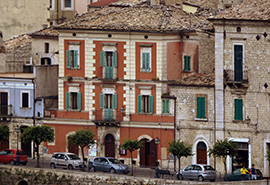The history of the Recchione family sums up in itself the history of one of the most important fields of manufacture in Palena, namely the production of woolen cloth.
The Recchione family, came to Palena from Civitella Alfedena, after a series of moves and changes of towns, during which its representatives had passed from the condition of wool workers to that of entrepreneurs. The last move, Palena, seemed to be the best place to settle due to the growth in this town for wool manufacturing.
During the eighteenth century the Counts of Aquino had introduced to Palena wool processing techniques to make cloth that was sold in the main Fayres in the center and south of Italy. To consolidate the sector of woolen cloth manufacturing in the next century, a series of protective measures were taken by the Bourbons, which gave a further boost to the small industrial group of Palena and which also benefited the Recchione family.
In January of 1826 Donato and Fedele Recchione obtained permission to use the royal stamp on their cloths, the so-called wild horses which marked the pieces of cloth from southern Italy. At the end of the same year Don Raffaele Recchione in partnership with the Falcocchio family built a wool processing plant consisting of five fulling mills on the river Aventine.
The family lived in a large mansion near the church of San Francesco, also where the painter Oreste Recchione lived his childhood. it was completely destroyed by bombing in World War II. The residence in Via Trento e Trieste came into their own property in the mid-nineteenth century when the Recchione family invested their profits in real estate. It was perhaps this building, in July 1846, to enter the 'priestly patrimony' of Croce, son of Fedele Recchione that had undertaken the priestly life.
The structure of the building is the classic one where the ground floor was converted into warehouse and storage, those were the two areas on either side of the main entrance, while the upper floors were for the family and their housing needs.

The history of the Recchione family sums up in itself the history of one of the most important fields of manufacture in Palena, namely the production of woolen cloth.
The Recchione family, came to Palena from Civitella Alfedena, after a series of moves and changes of towns, during which its representatives had passed from the condition of wool workers to that of entrepreneurs. The last move, Palena, seemed to be the best place to settle due to the growth in this town for wool manufacturing.
During the eighteenth century the Counts of Aquino had introduced to Palena wool processing techniques to make cloth that was sold in the main Fayres in the center and south of Italy. To consolidate the sector of woolen cloth manufacturing in the next century, a series of protective measures were taken by the Bourbons, which gave a further boost to the small industrial group of Palena and which also benefited the Recchione family.
In January of 1826 Donato and Fedele Recchione obtained permission to use the royal stamp on their cloths, the so-called wild horses which marked the pieces of cloth from southern Italy. At the end of the same year Don Raffaele Recchione in partnership with the Falcocchio family built a wool processing plant consisting of five fulling mills on the river Aventine.
The family lived in a large mansion near the church of San Francesco, also where the painter Oreste Recchione lived his childhood. it was completely destroyed by bombing in World War II. The residence in Via Trento e Trieste came into their own property in the mid-nineteenth century when the Recchione family invested their profits in real estate. It was perhaps this building, in July 1846, to enter the 'priestly patrimony' of Croce, son of Fedele Recchione that had undertaken the priestly life.
The structure of the building is the classic one where the ground floor was converted into warehouse and storage, those were the two areas on either side of the main entrance, while the upper floors were for the family and their housing needs.